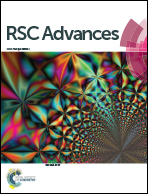Formation of pH-responsive drug-delivery systems by electrospinning of vesicle-templated nanocapsule solutions†
Abstract
A novel polyethylene oxide (PEO) nanofibrous membrane, which contains chitosan (CS)/sodium alginate (SA) or CS nanocapsules formed by vesicles as a template, has been designed as a pH-responsive drug-delivery system and fabricated via an electrospinning process. Three different vesicle systems, including didodecyldimethylammonium bromide (DDAB), cetyl trimethyl ammonium bromide (CTAB)/sodium dodecyl benzene sulfonate (SDBS) (7/3) and CTAB/SDBS (3/7), were employed as the templates to construct the nanocapsules and 5-fluoro-2,4(1H,3H)pyrimidinedione (5-Fu) was selected as the model drug to be loaded within the drug delivery system. Structural characterization of the composites was obtained by means of zeta potential and a digital microscope image. The pH-responsive behaviors of the nanocapsules made from three different surfactant systems were detected by fluorescence spectroscopy. Drug release from the electrospun nanofibers with nanocapsules made from these different systems was investigated by a UV-visible spectrophotometer. The result showed that these different drug-delivery systems exhibit different release rates and pH-responsive behaviors. They can be good candidates for anticancer therapy in the organism, especially in wound healing dressing used after surgical procedures to improve the therapeutic value and reduce the local toxicity of medicinal drugs in clinical practice.


 Please wait while we load your content...
Please wait while we load your content...